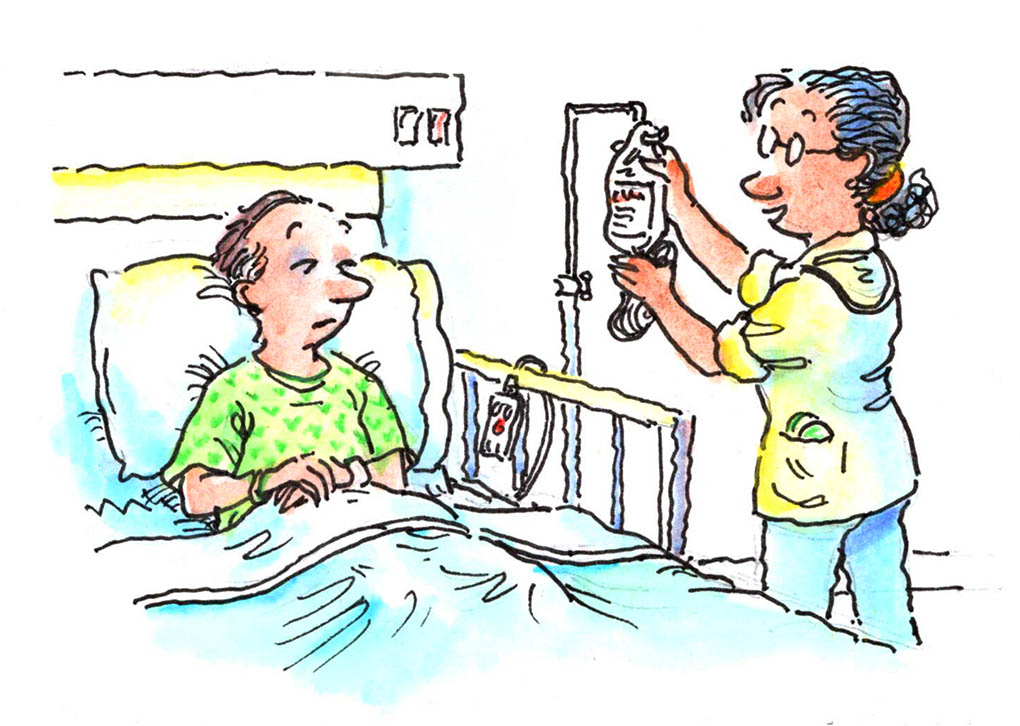The conditioning regimen is the chemotherapy and/or radiation you will receive in the days prior to your transplant. The conditioning regimen may also be called the preparative regimen, high-dose chemotherapy, or high-dose immunotherapy.
The conditioning regimen is designed to:
- kill your diseased cells and/or
- make room in your bone marrow for healthy blood stem cells
The conditioning regimen occurs in the hospital or an outpatient clinic over three to ten days.
 Chemotherapy
Chemotherapy
Most conditioning regimens include chemotherapy. The drugs used will depend on your disease, overall health, and the preferred treatment plan at your transplant center.
Drugs used in the conditioning regimen are sometimes the same as those used in standard chemotherapy to treat the disease. The dosage, however, may be much higher. Some conditioning regimens include both chemotherapy and immunotherapy.
Most chemotherapy drugs are given through a thin, flexible tube called a catheter or central venous line over a one to ten day period. The catheter is surgically implanted into a large vein in the neck or chest and placed so it rests just above the heart. It allows the medical staff to give drugs and blood products to you painlessly and to withdraw the many blood samples required during treatment without inserting needles into your arms.
The catheter may be left in place for several weeks or months after the transplant. Sometimes, it is attached to a device called a port that is inserted under the skin.
Total Body Irradiation (TBI)
Some conditioning regimens include total body irradiation (TBI), which is typically administered to patients over a one to seven day period. You will not actually see or feel the radiation, but you may still find TBI to be an unnerving experience
- You will sit or lie still, sometimes in an awkward position, for 10 to 45 minutes while the radiation is administered. This can be difficult, particularly if you are nauseated.
- Some transplant centers use special stands or boxes to help you remain still during TBI. These can be confining and may make you feel anxious.
Pre-medication with sedatives can help reduce anxiety. Children are usually sedated before TBI to minimize their movement. Very young children may be anesthetized.
It helps to visit the radiation center before TBI therapy begins to familiarize yourself with the equipment and to get your questions answered.
Most centers provide patients with a simulation of TBI so they know what to expect in advance and so the healthcare team can ensure that dosages and equipment measurements are correct.
Common Short-Term Side Effects
Because chemotherapy and TBI are toxic to normal tissues and organs, as well as your diseased cells, short-term side effects are common. Most of these side effects are temporary and completely reversible.
- Nausea, Vomiting, and Diarrhea
Nausea and vomiting are common following all conditioning regimens and are usually controlled with medications called antiemetics. The antiemetics can cause additional side effects, such as
- anxiety
- drowsiness
- restlessness
- muscle tightness
- uncontrolled eye movement
- shakiness.
- difficulty with urination
These drug reactions can be frightening but are usually less serious than they appear. Lowering the antiemetic dosage or administering an antihistamine usually reduces or eliminates the symptoms.
Diarrhea following the conditioning regimen is also common. Antidiarrheal drugs such as Imodium® or Lomotil® may sedate the nerves in the gastrointestinal area, slowing down muscle contractions and diarrhea.
- Mouth and Throat Sores
Cells that line the mouth, throat, and gut can be temporarily damaged by chemotherapy and radiation.
Mouth and throat sores typically appear four to eight days following the conditioning regimen.
- A variety of medications can help relieve the discomfort.
- Brushing your teeth and gums frequently with a soft brush or sponge and rinsing with a saline solution can help prevent mouth infections.
Mouth sores can make eating difficult. You may be fed intravenously until the discomfort subsides and your stomach is able to absorb sufficient nutrients. Mouth and throat irritation typically improve as your blood counts recover after transplant.
- Hair Loss
The conditioning regimen can cause temporary hair loss (alopecia). Hair loss changes your appearance and, for some, can be very distressing.
- Some patients prefer to shave their head or cut their hair very short before hair loss begins.
- Scarves, hats, or wigs can be used until the hair grows back.
Hair normally grows back within three to six months. Sometimes the amount of curl or thickness of the new hair will differ from your hair pre-transplant. In rare cases, hair loss is permanent.
- Skin Changes
Skin rash is common with conditioning regimens that include TBI, busulfan, etoposide, carmustine, or thiotepa.
Less often, dark spots appear on the skin. This is called hyperpigmentation and is most often seen in patients with a darker skin tone. The spots usually fade in one to three months.
- Bladder Irritation
Bladder irritation occasionally occurs following the conditioning regimen, particularly those that include cyclophosphamide or ifosfamide. It may cause bloody or painful urination.
To prevent or treat the problem your transplant team may:
- increase the flow of intravenous fluids
- use a catheter to irrigate your bladder
- give you a drug called MESNA®
- Liver Problems
Temporary liver damage occasionally occurs following the conditioning regimen. It is usually both mild and completely reversible. You may experience:
- jaundice (yellowing of the skin)
- significant weight gain due to fluid retention
- abnormal blood levels of liver enzymes and bilirubin (a pigment produced during the breakup of red blood cells)
Resting the liver and avoiding medications that aggravate the condition are the usual treatments until the liver heals itself.
Occasionally, a complication called sinusoidal obstruction syndrome (SOS) occurs after transplant, causing blood vessels that carry blood through the liver to become swollen and blocked. A drug called defibrotide is available to help treat this complication.
- Lungs and Heart
Breathing irregularities occasionally occur following the conditioning regimen. You may have difficulty taking a deep breath, develop a new cough, or have new findings on a chest X-ray that prompt the doctors to prescribe new medications or order new tests.
Occasionally, patients develop infectious pneumonia or lung inflammation that can lead to extra fluid in the lungs. If the problem is severe, the patient may be admitted to the intensive care unit (ICU). In most cases, the injury to the lungs is temporary.
Mild, temporary heartbeat irregularities (arrhythmia) or rapid heartbeat (tachycardia) can occur following the conditioning regimen, particularly after those that include cyclophosphamide or carmustine. Severe heart problems are rare.
- Confusion
Confusion is an occasional, temporary side effect of the preparative regimen or drugs used to control other side effects. Confusion can be frightening for both the patient and for loved ones who observe it. This problem is usually temporary and reversible and is typically managed by changing the dosage or type of drug that is causing the problem.
- Muscle Spasms
Muscle spasms or cramping are common after transplant and are usually caused by an imbalance in electrolytes — minerals found in the body such as potassium, magnesium and calcium.
The problem can often be resolved by taking supplements to replace lost minerals. Ask your doctor to prescribe the supplement since not all products containing these minerals are absorbed equally well by the body.
If there is no electrolyte imbalance, vitamin E or quinine may help. Before taking these supplements, ask your transplant team whether they are safe for you and will help.
- Infertility
The conditioning regimen often makes patients infertile. If you hope to have children after transplant, ask your doctor about steps you can take to preserve your fertility after Transplant. Go to the Preserving Fertility section of our website for information about fertility preservation.
- Fatigue
During the early recovery period, expect to feel very fatigued. Moderate exercise can help you regain your strength and stamina.

Most transplant programs encourate patients to walk the hallways to build strength. Some programs have stationary bikes patients can ride to improve stamina. Even a little bit of daily exercise is helpful for your recovery. Consult with your transplant team about the appropriate amount of exercise for you.
Late and Long-Term Side Effects
Some of the side effects of the conditioning regimen can persist for months. Others may not develop until several years after transplant.
Go to the Late and Long-Term Side Effects section of our website to learn more about complications that may persist or emerge long-term after transplant.
Putting Short-Term Risks into Perspective
Anxiety about the possible side effects of the conditioning regimen is normal. It helps to put the risk of developing each side effect into perspective and to remember that most are temporary and completely reversible. Mental health providers are available at most transplant centers to help you cope with your anxiety.


